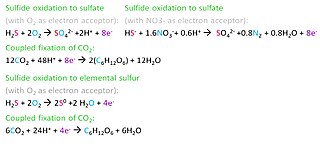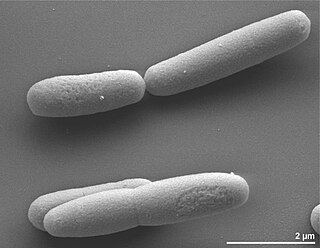Related Research Articles

Acidobacteriota is a phylum of Gram-negative bacteria. Its members are physiologically diverse and ubiquitous, especially in soils, but are under-represented in culture.
The Desulfobacteraceae are a family of Thermodesulfobacteriota. They reduce sulfates to sulfides to obtain energy and are strictly anaerobic. They have a respiratory and fermentative type of metabolism. Some species are chemolithotrophic and use inorganic materials to obtain energy and use hydrogen as their electron donor.
Sulfur-reducing bacteria are microorganisms able to reduce elemental sulfur (S0) to hydrogen sulfide (H2S). These microbes use inorganic sulfur compounds as electron acceptors to sustain several activities such as respiration, conserving energy and growth, in absence of oxygen. The final product or these processes, sulfide, has a considerable influence on the chemistry of the environment and, in addition, is used as electron donor for a large variety of microbial metabolisms. Several types of bacteria and many non-methanogenic archaea can reduce sulfur. Microbial sulfur reduction was already shown in early studies, which highlighted the first proof of S0 reduction in a vibrioid bacterium from mud, with sulfur as electron acceptor and H2 as electron donor. The first pure cultured species of sulfur-reducing bacteria, Desulfuromonas acetoxidans, was discovered in 1976 and described by Pfennig Norbert and Biebel Hanno as an anaerobic sulfur-reducing and acetate-oxidizing bacterium, not able to reduce sulfate. Only few taxa are true sulfur-reducing bacteria, using sulfur reduction as the only or main catabolic reaction. Normally, they couple this reaction with the oxidation of acetate, succinate or other organic compounds. In general, sulfate-reducing bacteria are able to use both sulfate and elemental sulfur as electron acceptors. Thanks to its abundancy and thermodynamic stability, sulfate is the most studied electron acceptor for anaerobic respiration that involves sulfur compounds. Elemental sulfur, however, is very abundant and important, especially in deep-sea hydrothermal vents, hot springs and other extreme environments, making its isolation more difficult. Some bacteria – such as Proteus, Campylobacter, Pseudomonas and Salmonella – have the ability to reduce sulfur, but can also use oxygen and other terminal electron acceptors.
Dehalococcoides is a genus of bacteria within class Dehalococcoidia that obtain energy via the oxidation of hydrogen and subsequent reductive dehalogenation of halogenated organic compounds in a mode of anaerobic respiration called organohalide respiration. They are well known for their great potential to remediate halogenated ethenes and aromatics. They are the only bacteria known to transform highly chlorinated dioxins, PCBs. In addition, they are the only known bacteria to transform tetrachloroethene to ethene.
Desulfatibacillum alkenivorans AK-01 is a specific strain of Desulfatibacillum alkenivorans.

Gammaproteobacteria is a class of bacteria in the phylum Pseudomonadota. It contains about 250 genera, which makes it the most genera-rich taxon of the Prokaryotes. Several medically, ecologically, and scientifically important groups of bacteria belong to this class. It is composed by all Gram-negative microbes and is the most phylogenetically and physiologically diverse class of Proteobacteria.

Bacterial phyla constitute the major lineages of the domain Bacteria. While the exact definition of a bacterial phylum is debated, a popular definition is that a bacterial phylum is a monophyletic lineage of bacteria whose 16S rRNA genes share a pairwise sequence identity of ~75% or less with those of the members of other bacterial phyla.
Alteromonas macleodii is a species of widespread marine bacterium found in surface waters across temperate and tropical regions. First discovered in a survey of aerobic bacteria in 1972, A. macleodii has since been placed within the phylum Pseudomonadota and is recognised as a prominent component of surface waters between 0 and 50 metres. Alteromonas macleodii has a single circular DNA chromosome of 4.6 million base pairs. Variable regions in the genome of A. macleodii confer functional diversity to closely related strains and facilitate different lifestyles and strategies. Certain A. macleodii strains are currently being explored for their industrial uses, including in cosmetics, bioethanol production and rare earth mining.
Desulfosporosinus is a genus of strictly anaerobic, sulfate-reducing bacteria, often found in soil.
"Candidatus Scalindua" is a bacterial genus, and a proposed member of the order Planctomycetales. These bacteria lack peptidoglycan in their cell wall and have a compartmentalized cytoplasm. They are ammonium oxidizing bacteria found in marine environments.
Desulfomonile tiedjei is a bacterium. It is anaerobic, dehalogenating, sulfate-reducing, Gram-negative, non-motile, non-spore-forming and rod-shaped. Its type strain is DCB-1.
Desulfobacterium indolicum is an oval to rod-shaped, Gram-negative, non-sporing sulfate-reducing bacterium. Its type strain is In04. It is notable for its use of particular metabolic pathways, including desulfurization of diesel.
Desulfobacter latus is a sulfate-reducing bacteria, with type strain AcRS2.
Desulfobacterium is a rod-shaped bacteria genus from the family of Desulfobacteraceae. Desulfobacterium occur widespread in brackish and marine sediments.
Desulfobacula toluolica is a Gram-negative and sulfate-reducing bacterium from the genus of Desulfobacula which has been isolated from marine mud in the United States.
Methylophaga thiooxydans is a methylotrophic bacterium that requires high salt concentrations for growth. It was originally isolated from a culture of the algae Emiliania huxleyi, where it grows by breaking down dimethylsulfoniopropionate from E. hexleyi into dimethylsulfide and acrylate. M. thiooxydans has been implicated as a dominant organism in phytoplankton blooms, where it consumes dimethylsulfide, methanol and methyl bromide released by dying phytoplankton. It was also identified as one of the dominant organisms present in the plume following the Deepwater Horizon oil spill, and was identified as a major player in the breakdown of methanol in coastal surface water in the English channel.

Microbial oxidation of sulfur is the oxidation of sulfur by microorganisms to build their structural components. The oxidation of inorganic compounds is the strategy primarily used by chemolithotrophic microorganisms to obtain energy to survive, grow and reproduce. Some inorganic forms of reduced sulfur, mainly sulfide (H2S/HS−) and elemental sulfur (S0), can be oxidized by chemolithotrophic sulfur-oxidizing prokaryotes, usually coupled to the reduction of energy-rich oxygen (O2) or nitrate (NO3−). Anaerobic sulfur oxidizers include photolithoautotrophs that obtain their energy from sunlight, hydrogen from sulfide, and carbon from carbon dioxide (CO2).
Fermentibacteria is a bacterial phylum with candidate status. It is part of the FCB group.
"CandidatusThiodictyon syntrophicum" is a gram-negative bacterium classified within purple sulfur bacteria (PSB). "Ca. T. syntrophicum" grows best under micro-oxic and low light conditions. There has only been one successful enrichment of "Ca. T. syntrophicum"; "Ca. T. syntrophicum" strain Cad16T.

Halanaerobium praevalens is a moderately alkaliphilic, extremely halophilic bacterium that was first isolated from surface sediments of the Great Salt Lake, Utah and described by J.G. Zeikus et al. in 1983, with IJSB validation in 1984.
References
- ↑ Brysch, K.; Schneider, C.; Fuchs, G.; Widdel, F. (1987). "Lithoautotrophic growth of sulfate-reducing bacteria, and description of Desulfobacterium autotrophicum gen. nov., sp. nov". Archives of Microbiology. 148 (4): 264–274. doi:10.1007/BF00456703. ISSN 0302-8933. S2CID 6687270.
- ↑ Strittmatter, Axel W.; Liesegang, Heiko; Rabus, Ralf; Decker, Iwona; Amann, Judith; Andres, Sönke; Henne, Anke; Fricke, Wolfgang Florian; Martinez-Arias, Rosa; Bartels, Daniela; Goesmann, Alexander; Krause, Lutz; Pühler, Alfred; Klenk, Hans-Peter; Richter, Michael; Schüler, Margarete; Glöckner, Frank Oliver; Meyerdierks, Anke; Gottschalk, Gerhard; Amann, Rudolf (2009). "Genome sequence of Desulfobacterium autotrophicum HRM2, a marine sulfate reducer oxidizing organic carbon completely to carbon dioxide". Environmental Microbiology. 11 (5): 1038–1055. doi:10.1111/j.1462-2920.2008.01825.x. ISSN 1462-2912. PMC 2702500 . PMID 19187283.